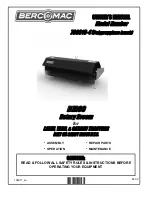
Note
Improper handling can result in malfunctions.
· Make sure that the following specifications are always observed:
· Compare the maximum values specified in these operating instructions with
your actual application (e.g. operating media, pressures, forces, torques,
temperatures, masses, speeds, operating voltages, flow rates).
· Take into consideration the ambient conditions at the location of use.
· Please comply with national and local safety laws and regulations.
· Remove all transport packing such as protective wax, foils (polyamide), caps
(polyethylene), cardboard boxes (except for the sealing elements of the
pneumatic connections).
The packing is intended for recycling (except for: oiled paper = other waste).
· Use the product in its original state. Unauthorized modification is not permitted.
4
Installation
4.1 Mechanical assembly
Note
Interference due to electromagnetic influences can cause damage.
· When installing the SFAB, make sure that a lateral distance of x = 10 mm from
earthed surfaces is maintained
è
Fig.3
Ū
Fig.5.
It can be fitted in any position. Fasten the SFAB as follows:
hat rail (battery mounting)
1.
Hang the SFAB onto the hat rail.
2.
Press the SFAB in the direction of the
arrow until the fastening rale catches
è
Fig.3.
Fig.3
Wall mounting
1.
Attach the adapter plate, such as with
two M3 screws.
2.
Hang the SFAB onto the adapter plate.
3.
Press the SFAB in the direction of the
arrow until the fastening rale catches
è
Fig.4.
Fig.4
Plate mounting (threaded mounting)
· Attach the SFAB with washers and M4
screws.
Tightening torque
1 Nm
Fig.5
Turn the display
The display can be rotated in 90° steps.
The range of rotationis limited by a stop to
about 270°.
Fig.6
4.2 Pneumatic connection
The air mass stream is added at connection 1 and removed at connection 2
è
Fig.1.
Hook up hoses to the SFAB as follows:
· Insert the two hoses into the PlugIn connections
of connection 1 and
connection 2
è
Marking on the product.
Note
If the hoses are connected to the SFAB incorrectly, the measurement values will
flash in the display.
4.3 Electrical connection
Warning
Use only power units which guarantee reliable electrical isolation of the
operating voltage as per IEC/DIN EN 60204−1.
Observe also the general requirements for PELV power circuits as per
IEC/DINEN 60204−1.
Switch power packs are permitted, providing they guarantee reliable isolation in
accordance with EN 60950/VDE 0805.
Note
Long signal cables reduce the immunity to interference.
· Make sure that the signal cables are shorter than 10 m.
Note
The binary outputs at pin2 and pin3 can be wired as PNP or NPN connections as
needed.
· Make sure that you also configure the binary outputs according to your wiring
è
Setting special menu [SPEC] section.
· Wire the SFAB as follows:
Pin
Assignment
Core colours
1)
Plug
2)
1
DC +24 V operating voltage
brown (BN)
5−pin M12
1
2
Binary outputsB (OutB)
white (WH)
1
3
0V
blue (BU)
2
4
4
Binary outputA (OutA)
black (BK)
5
2
4
5
Analogue outputC (OutC)
3)
grey (GY)
5
3
1)
With use of the connecting cable from the electrical accessories
è
chapter 1.2 Characteristics
2)
The tightening torque for the union nut at the plug is max. 0.5Nm.
3)
Voltage U and current I
è
chapter 11, Technical specifications
Fig.7
Circuit diagrams
SFAB−
Ū
−2SA
SFAB−
Ū
−2SV
Fig.8
5
Commissioning
1.
Switch on the operating voltage.
2.
Establish the desired switching behaviour of the binary outputs.
· With flow measurement [FLW]: Switching points [SP] and hysteresis [Hy]
è
Fig.9.
· With accumulated air consumption measurement [ConS], only with Out A,
consumption switch impulse [CI]
è
Fig.10.
Switching point and hysteresis with flow measurement for Out A / Out B
Threshold comparator
Window comparator
Switch element function NO (closer)
q
1
0
Hy
OUT
SP
[l/min]
Hy
Hy
q
1
0
OUT
SP Lo
SP Hi
[l/min]
Switching element function NC (normally closed)
q
1
0
SP
Hy
OUT
[l/min]
q
1
0
OUT
SP Lo
SP Hi
Hy
Hy
[l/min]
Fig.9


























